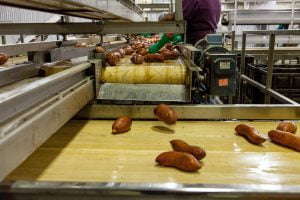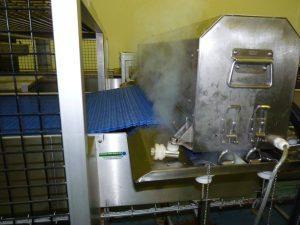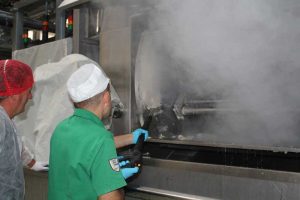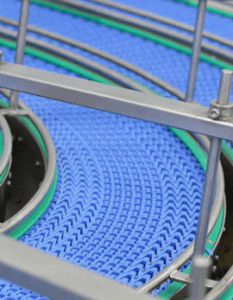HACCP stands for Hazard Analysis and Critical Control Points. It is a systematic approach to identifying and controlling potential hazards in food production processes. HACCP is an internationally recognized system that helps ensure food safety by identifying critical control points where hazards can be prevented, eliminated, or reduced to acceptable levels.
HACCP compliance is of utmost importance in the food industry as it helps prevent foodborne illnesses and ensures that food products are safe for consumption. It involves implementing preventive measures at each stage of the production process to minimize the risk of contamination. Failure to comply with HACCP regulations can result in severe consequences, including product recalls, legal action, damage to reputation, and loss of consumer trust.
Importance of Conveyor Belt Cleaning in HACCP Compliance
Conveyor belt cleaning plays a vital role in HACCP compliance as it is considered a critical control point in the production process. Contaminated conveyor belts can introduce various hazards into the food production line, including physical contaminants like dirt and debris, chemical contaminants from cleaning agents or lubricants, and biological contaminants such as bacteria and mould.
Regular and effective cleaning of conveyor belts helps prevent cross-contamination between different food products and ensures that any potential hazards are eliminated. It is essential to establish proper cleaning procedures, including the use of appropriate cleaning agents and equipment, to maintain a high level of hygiene and comply with HACCP regulations.
Non-compliance with HACCP regulations can have severe consequences for businesses in the food industry. In addition to the potential health risks to consumers, non-compliance can lead to product recalls, legal penalties, and damage to a company’s reputation. Therefore, it is crucial for businesses to prioritize conveyor belt cleaning as part of their HACCP compliance efforts.
Traditional Methods of Conveyor Belt Cleaning
Traditionally, conveyor belt cleaning has been done using manual scrubbing or pressure washing methods. Manual scrubbing involves physically scrubbing the conveyor belt with brushes or sponges and using cleaning agents to remove dirt and debris. Pressure washing uses high-pressure water jets to clean the belt surface.
While these methods can be effective to some extent, they have several limitations. Manual scrubbing is time-consuming and labor-intensive, requiring dedicated personnel to clean the belts regularly. It is also challenging to ensure consistent and thorough cleaning across the entire belt surface, especially in hard-to-reach areas.
Pressure washing, on the other hand, can be more efficient in terms of time and labor. However, it often requires large amounts of water, which can lead to water waste and environmental concerns. Additionally, pressure washing may not effectively remove all types of contaminants, especially those that are ingrained or stuck onto the belt surface.
Limitations of Traditional Methods
| Method | Pros | Cons |
|---|---|---|
| Manual Scraper | Low cost, easy to use | Labour intensive, inconsistent results |
| Chemical Cleaning | Effective at removing stubborn debris | Can be harmful to environment and conveyor belt |
| High Pressure Water Jetting | Quick and efficient, can be automated | Can damage conveyor belt, high water usage |
| Air Knife | Non-contact cleaning, low maintenance | Less effective on wet debris, high initial cost |
The limitations of traditional conveyor belt cleaning methods can pose significant challenges for businesses striving for HACCP compliance. Incomplete cleaning can leave behind traces of contaminants on the belt surface, increasing the risk of cross-contamination during food production. This can compromise food safety and put consumers at risk.
Water waste is another concern associated with traditional cleaning methods. Excessive water usage not only leads to increased costs but also has environmental implications. In an era where sustainability is a growing concern, businesses need to find more efficient and eco-friendly alternatives for conveyor belt cleaning.
Introduction to Steam Vapour Cleaning Machines
Steam vapour cleaning machines offer a revolutionary solution to the challenges faced by traditional conveyor belt cleaning methods. These machines use high-temperature steam to clean and sanitize conveyor belts effectively. The steam is produced by heating water to a high temperature, creating dry steam that can penetrate deep into the belt surface and remove dirt, debris, and contaminants.
Steam vapour cleaning machines work by delivering a controlled amount of steam onto the conveyor belt surface through a nozzle or brush attachment. The high temperature of the steam helps break down and dissolve dirt and grime, while the pressure helps dislodge contaminants from the belt surface. The steam also has sanitizing properties, killing bacteria and other pathogens on contact.
Benefits of Using Steam Vapour Cleaning Machines

Using steam vapour cleaning machines for conveyor belt cleaning offers several advantages over traditional methods. Firstly, these machines require minimal water usage compared to pressure washing, making them more environmentally friendly and cost-effective. The dry steam produced by these machines evaporates quickly, leaving behind no residue or excess moisture on the belt surface.
Steam vapour cleaning machines also provide superior cleaning efficacy compared to manual scrubbing. The high temperature of the steam helps dissolve and remove even ingrained or stubborn contaminants from the belt surface. This ensures a thorough and consistent cleaning process, reducing the risk of cross-contamination during food production.
Moreover, steam vapour cleaning machines offer a chemical-free cleaning solution. The high temperature of the steam is sufficient to kill bacteria and other pathogens without the need for additional sanitizing agents. This eliminates the risk of chemical residues on the conveyor belts, ensuring food safety and compliance with HACCP regulations.
Automatic Conveyor Belt Steam Vacuum: A Revolutionary Solution
The automatic conveyor belt steam vacuum takes the benefits of steam vapour cleaning machines to the next level. This innovative technology combines the power of steam cleaning with the efficiency of vacuuming, providing a comprehensive and automated solution for conveyor belt cleaning.
The automatic conveyor belt steam vacuum is designed to be integrated into existing conveyor systems, allowing for continuous and automated cleaning. The machine is equipped with a steam generator, a vacuum system, and a brush or nozzle attachment that moves along the belt surface. The steam is applied to the belt, loosening and removing contaminants, while the vacuum system simultaneously sucks up the dirt and debris.
Advantages of Automatic Conveyor Belt Steam Vacuum
The advantages of the automatic conveyor belt steam vacuum are numerous. Firstly, this technology significantly reduces labor costs and manual effort required for conveyor belt cleaning. The automated system can operate continuously, eliminating the need for dedicated personnel to clean the belts manually. This frees up resources and allows employees to focus on other critical tasks.
The automatic conveyor belt steam vacuum also improves cleaning efficiency and effectiveness. The combination of steam cleaning and vacuuming ensures thorough removal of contaminants from the belt surface, leaving it clean and sanitized. The continuous operation of the machine ensures consistent cleaning across the entire belt, including hard-to-reach areas.
Furthermore, this technology helps businesses achieve HACCP compliance more effectively. The automated system ensures that conveyor belts are cleaned regularly and consistently, minimizing the risk of cross-contamination during food production. The use of high-temperature steam eliminates bacteria and other pathogens, ensuring food safety and compliance with HACCP regulations.
Making the Switch to Conveyor Belt Steam Cleaning
In conclusion, conveyor belt cleaning is a critical aspect of maintaining hygiene and safety in various industries, particularly in the food industry. HACCP compliance is essential for ensuring food safety and preventing potential health hazards for consumers.
Traditional methods of conveyor belt cleaning have limitations in terms of efficiency, effectiveness, and environmental impact. Steam vapour cleaning machines offer a revolutionary solution by providing superior cleaning efficacy, reduced water usage, and chemical-free sanitization.
The automatic conveyor belt steam vacuum takes steam cleaning to the next level by providing an automated and comprehensive solution for conveyor belt cleaning. This technology offers numerous advantages, including reduced labor costs, improved cleaning efficiency, and enhanced HACCP compliance.
Businesses in the food industry should prioritize conveyor belt cleaning and consider adopting these new technologies to ensure food safety, comply with HACCP regulations, and maintain a high level of hygiene throughout their production processes. By making the switch to conveyor belt steam cleaning, businesses can protect their consumers, their reputation, and their bottom line.
FAQs
What is HACCP compliance?
HACCP stands for Hazard Analysis and Critical Control Points. It is a food safety management system that identifies and controls potential hazards in the food production process.
What is a conveyor belt cleaning system?
A conveyor belt cleaning system is a device or set of devices used to clean conveyor belts in food production facilities. It can include brushes, scrapers, sprayers, and other components.
How can a conveyor belt cleaning system help me achieve HACCP compliance?
A conveyor belt cleaning system can help you achieve HACCP compliance by reducing the risk of contamination from food residues, allergens, and other hazards. It can also help you meet hygiene and sanitation standards required by regulatory bodies.
What are the benefits of using a conveyor belt cleaning system?
The benefits of using a conveyor belt cleaning system include improved food safety, reduced risk of contamination, increased productivity, and reduced maintenance costs.
What factors should I consider when choosing a conveyor belt cleaning system?
When choosing a conveyor belt cleaning system, you should consider factors such as the type of food being produced, the size and layout of your facility, the level of automation required, and your budget.
Are there different types of conveyor belt cleaning systems?
Yes, there are different types of conveyor belt cleaning systems, including dry cleaning systems, wet cleaning systems, and steam cleaning systems. Each type has its own advantages and disadvantages, depending on the specific needs of your facility.
Do I need to train my staff to use a conveyor belt cleaning system?
Yes, it is important to train your staff to use a conveyor belt cleaning system properly to ensure effective cleaning and prevent damage to the equipment. Training should include proper use of the equipment, safety procedures, and maintenance requirements.









